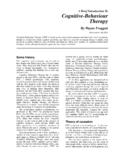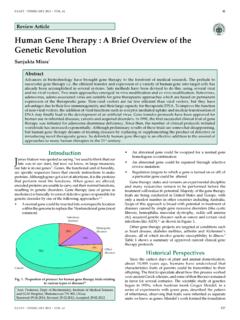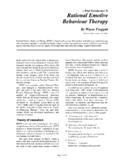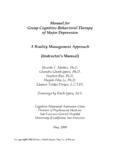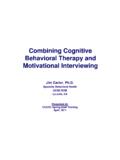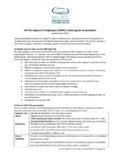Transcription of The Flash Technique in EMDR - coherencetherapy.org
1 TRANSCRIPT OF WEBINAR VIDEO ON YOUTUBE: The Flash Technique in EMDR How and why it works, as understood according to memory reconsolidation research Bruce Ecker, MA, LMFT Co-director, Coherence Psychology Institute I m Bruce Ecker and this is a mini-webinar on the Flash Technique in EMDR therapy, an analysis of how and why the Flash Technique works, in light of the principles of memory reconsolidation. This mini-webinar is intended for EMDR practitioners who are already familiar with how the Flash Technique is carried out. So I won t be explaining the step-by-step Flash Technique protocol, and I ll be assuming you know the procedure. The formal debut of Flash Technique was in this 2017 article by Philip Manfield, Joan Lovett, Lewis Engel, and David Manfield.* The explanation of Flash Technique s effectiveness that I m about to spell out differs in some significant ways from the explanation provided by these authors, and I ll say more about that farther along. Flash Technique is for cases where the client cannot tolerate or allow any experiential accessing of the traumatic memory, and has a SUDs level of 9 or 10 just from anticipating touching the memory at all, before even doing so.
2 ( Flash Technique is also effective for less severe SUDs levels). Access to the memory is strongly blocked by dissociation or some type of avoidance, or else accessing begins but immediately creates hyperactivation, retraumatization and dissociation. Either way, it s then impossible to proceed with the standard EMDR protocol. What I propose is that these are cases in which the client s subcortical, emotional brain has designated the traumatic memory as having what I ll call absolute lethal status. In other words, the client s emotional brain has formed an implicit, non-conscious expectation, which, if put into _____ * Manfield, P., Lovett, J., Engel, L., & Manfield, D. (2017). Use of the Flash Technique in EMDR therapy: Four case examples. Journal of EMDR Practice and Research, 11(4), 195 205. doi: 2018 Coherence Psychology Institute LLC. All rights reserved. The Flash Technique in EMDR: How and why it works 2018 Coherence Psychology Institute LLC All rights reserved 2 words, would be something like, If there is any smallest degree of conscious experience of this memory, I ll be completely overwhelmed by agony and helplessly stuck in that agony with no exit and never recover.
3 This memory is vastly more powerful than I am, and touching the memory even once will engulf me in agony forever, destroying my life. That expectation is what s making the memory maximally terrifying to touch and maximally urgent to always keep deeply and totally suppressed out of awareness. In my opinion, what s critical to recognize in order to see how the Flash Technique works is that the assigning of that absolute lethal status to the memory by the emotional brain is itself an emotional learning, one that is distinct from the contents of the traumatic memory. It s the implicit emotional learning that any conscious contact with this memory will destroy me. The key idea I m proposing is that the Flash Technique s target is that emotional learning of the memory s absolute lethal status not the content of the traumatic memory itself, but rather, its absolute lethal status. With that idea in mind, now let s look at what happens to that target learning of absolute lethal status as the Flash Technique is carried out.
4 And as we do that, let s bear in mind also what we know from memory reconsolidation research: A target learning s neural encoding becomes destabilized and de-consolidated in other words, unlocked when that target learning is reactivated and, while reactivated, is mismatched by a perception or experience that is different from what the target learning knows and expects. Then, during that unlocked state that lasts for a few hours, a new learning that is contradictory to the target learning can make the target learning be profoundly unlearned, unwired and replaced by that new, contradictory learning. Not just regulated by the new learning, but erased and replaced by it, for a transformational change that is permanent. Ok, now let s look at what happens to the target learning of absolute lethal status as the Flash Technique procedure is carried out. First, the client listens to the therapist s instructions to have contact with the traumatic memory in an extremely brief and indistinct way.
5 Well, that certainly reactivates the target learning of absolute lethal status. Any suggestion to make contact with the traumatic memory activates and alarms the emotional brain s knowledge that that memory has absolute lethal status. And those instructions go on for many minutes. So, that is a lengthy, solid reactivation of the target learning. Also, the client s emotional brain then notices that what is being requested is an extremely brief and indistinct contact with the memory, much more brief and indistinct than the client s emotional brain ever considered to be a possibility. That s a surprise to the emotional brain and remember, surprise means a mismatch or prediction error is happening. Next, the prospect of going ahead and contacting the memory in this extremely brief and indistinct way feels workable to the client s emotional brain, it feels not too unsafe to do, and that too is a The Flash Technique in EMDR: How and why it works 2018 Coherence Psychology Institute LLC All rights reserved 3 surprise and another mismatch.
6 And because it feels workable, resistance and fear do not block the process. And then the client goes ahead for the first time and flashes on the memory in this extremely brief and indistinct way, and finds that, sure enough, it wasn t harmful to do that. And that s the biggest surprise of all, to the emotional brain, and it registers as a distinct mismatch of the target learning, the absolute lethal status of the memory. In other words, the experience in the client s emotional brain, depicted in words, is something like, What? I touched that memory and nothing bad happened to me? That s not what I expected! That means it s not absolutely lethal after all! And that is the creation of the contradictory knowledge, I touched that memory and wasn t harmed by touching it. Now, the activated expectation of absolute lethality, and the disconfirmation of that expectation, are in the same field of awareness, in juxtaposition. That juxtaposition experience is the biggest, strongest mismatch yet, and as I reviewed earlier, mismatch during reactivation is exactly what unlocks the neural encoding of the target learning, launching the memory reconsolidation process.
7 Now the destabilized target learning of absolute lethal status is available to being fundamentally unlearned, nullified and replaced by new learning. And that new learning is then supplied by several more flashes. Flash Technique protocol calls for a total of 6 to 12 flashes, each of which again puts the target learning into juxtaposition with the experiential, contradictory recognition, I touched the memory and wasn t harmed by doing that. That knowledge of being unharmed and safe is of course bolstered by the dual focus that maintains awareness of being accompanied by the therapist in the therapist s office, in parallel with doing the flashes. At the end of the flashes, the absolute lethal status of the traumatic memory has been thoroughly unlearned and nullified. But there has been no change made in the specific content of the traumatic memory itself, including the emotional distress that the client would feel from bringing that content into awareness. What has changed is only the emotional brain s expectation of being plunged into unending mental and emotional agony by touching that memory at all.
8 It s that terrifying expectation that was generating the client s high level of distress, the high SUDs level; so the unlearning of that expectation is what causes the observed dramatic reduction in the client s SUDs level, according to this analysis. In this view, for the Flash Technique to work, what s needed is reactivation of that expectation of the absolute lethality of the memory, not reactivation of the memory s contents. Some EMDR practitioners wonder how such an ultra-brief and completely blurry glance at the traumatic memory can possibly reactivate it adequately for new processing to occur, and people are citing memory research on rapid reactivation. However, according to the analysis I m delineating here, that entire question is irrelevant, because in this view, the traumatic memory isn t the target of the Flash Technique . The target is the expectation of being permanently engulfed, The Flash Technique in EMDR: How and why it works 2018 Coherence Psychology Institute LLC All rights reserved 4 tortured and deranged by the memory after touching it once.
9 And that expectation is reactivated explicitly, directly, solidly, and at length by the Flash Technique protocol, as I described earlier, and then is very specifically disconfirmed and unlearned by a contradictory new learning again and again and again. In contrast, in the article by the Flash Technique originators, the traumatic memory itself is viewed as the target. They do invoke memory reconsolidation and they identify mismatches and contradictory experiences to support that analysis. Nevertheless, the extreme brevity and, perhaps even more importantly, the total blurriness of the Flash do raise doubts about reactivating the traumatic memory, because studies of ultra-rapid memory reactivation have used highly specific reactivation cues that are components of the target learning being reactivated. There is one other consideration that I thinks warrants mentioning here because it independently arrives at the same conclusion: It s a frequent observation made by trauma therapists, including EMDR practitioners, that what reduces the emotional distress of a traumatic memory is a deep change in the implicit beliefs and expectations involved in the memory what EMDR terms negative cognitions.
10 Most of the emotional distress of a traumatic memory arises directly from those negative cognitions, as a rule, so when those cognitions are dissolved, the distress in turn reduces sharply. But Flash Technique does not act upon or change the negative cognitions of a traumatic memory, as is acknowledged in the 2017 Flash Technique article by Manfield et al.; and that implies that the big reduction of emotional distress produced by Flash Technique is not due to any change induced in the traumatic memory itself. The negative cognition that is targeted and dissolved by Flash Technique is the one I ve identified in this analysis, namely, I ll be engulfed and trapped in torment if I give that memory any opening at all. So we have to infer that it s the dissolving of that negative cognition that causes the reduction of the client s SUDs level. And that negative cognition is distinct from the traumatic memory itself, as I said earlier. This analysis can be pushed a little further, in the following way: What if we assume that after the Flash Technique procedure has been completed, essentially all distress due to the absolute lethal status expectation is gone, so any remaining distress must be due to the traumatic memory itself, which is unaffected by Flash Technique , according to this analysis.
